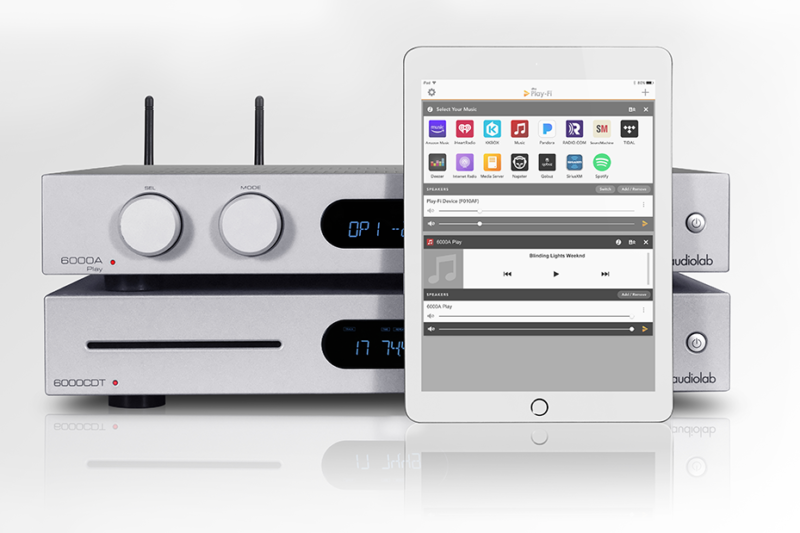 When I first heard about the $1299 6000A Play Wireless Audio Streaming Amp, I was ecstatic.
When I first heard about the $1299 6000A Play Wireless Audio Streaming Amp, I was ecstatic.
I’ve been a huge fan of Audiolab’s $999 6000A Integrated Amp and their $649 6000N Play Network Streamer (one of our 2019 Products of the Year), so when they announced a combination product, I couldn’t wait to get my hands on one.
To that end, Audiolab’s distributor was kind enough to provide me with one of the first units to hit the U.S., and I have spent the last few months using it alongside (more like below) their $549 6000CDT CD Transport.
The combo has been nothing short of breathtaking.
When it comes to the 6000A Play, Audiolab has done a great job of blending the 6000A and 6000N Play, coming up with a product that I feel is greater than the sum of its parts.
First of all, it retains the sleek, minimalist lines of the 6000A that I initially fell in love with. The perfectly-sized, smooth-turning operation knobs return, as does the classy oval display.
On the back panel, you still get five analog inputs, including the MM Phono input. The four digital inputs (2 Optical, 2 Coax) are also back, now accompanied by an ethernet connection (brought over from the 6000N Play) for wired networking.
Under the hood, the 6000A Play inherits the 6000A’s 2 x 50W into 8 ohms (2 x 75 into 4 ohms) Class AB amplifier section, along with the ESS Sabre 32-bit ES9018K2M Reference DAC chip.
Again you get the option of three different DAC filters with which you can tailor the sound alongside three operational modes (Integrated Mode; Pre-Power Mode; Pre Mode).
The three modes let you use just the power amp section alone, or only the pre-amp section, or of course, both of them together.

Streaming Magic
However, this time, inside the sleek chassis also resides the streaming circuitry of the 6000N Play, which is probably the most refined music streamer I’ve heard under a grand.
This means you get DTS Play-Fi, a huge multi-brand platform that lets you pull music from a ton of music services, including TIDAL and Qobuz. Spotify connect is also an option, meaning you can play music direct to the 6000A Play from Spotify apps.
To use Play-Fi, you download the free app (available for Android, iOS, and Windows) and connect to a Play-Fi device like the 6000A Play. From the app, you select your music source (in my case TIDAL and a NAS drive) and then choose either a track, playlist, or complete album to play.
As stated earlier, Play-Fi is a multi-brand platform that works on products from brands like SVS, McIntosh, and Paradigm. Play-Fi is also a multi-room platform so that you can play the same music on several different Play-Fi devices in several other rooms.

Not A CD Player, A Transport
The second half of my Audiolab system consisted of the Audiolab 6000CDT CD Transport. This disc reader extracts the digital music signals from CDs and sends it out the two digital outputs. You get a choice of either optical or coax. There are no analog outputs, which makes it a CD Transport, not a CD Player.
You have to connect it to a device with a DAC for it to work. Thankfully, the 6000A Play has an excellent 32-bit DAC built-in, and when you play a disc in the 6000CDT, the quality of the 6000A’s digital to analog converter becomes evident.
Like the 6000A Play, the 6000CDT also benefits from Audiolab’s sleek and minimalist design language. Again there’s the elegant oval LCD display, now joined by two rows of small buttons used to control the sophisticated slot-loading mechanism.
That mechanism is said to be the same as the one in their 8300CD flagship CD player, and I believe it. The motion of the CD slipping in and out of the slot opening is smooth like butter.
The 6000CDT is also advertised to have a read-ahead digital buffer to reduce disc-reading failures, making it able to play scratched and damaged CDs.
I don’t own any severely damaged CDs, but I do have a few from the Goodwill with visible scratches. All of them played flawlessly in the Audiolab deck.

Listening to the 6000A Play/6000CDT System
I listened to the 6000A Play/6000CDT combo using three different sources. First, from the BT Transmitter using aptX, then with the built-in streamer connected to TIDAL, then with the CD Transport.
The majority of my listening was done via the 6000CDT, followed by the Play-Fi streamer, so that’s where the bulk of my impressions come from. I also did a bit of listening via the BT input (aptX) on the 6000A Play, and while I found it quite engaging for BT, it didn’t quite match the transparency of the CD Transport and Play-Fi.
That being said, just like with the BT input on the 6000A stand-alone integrated, I found myself using it when I wanted to get some music playing in the background quickly, or for company.
I also found myself doing some critical listening with it on certain recordings, which surprised me. If I didn’t have the Wi-Fi streamer or CD to compare it to, I could see myself living with the aptX stream.
As far as speakers are concerned, I paired the system up with a pair of Kef LS50s, which list for $1299, precisely the same price as the 6000A Play. They are a pair of speakers that require an amp with some gusto, and I just knew the high-current Class AB amp in the Audiolab would be able to meet the challenge. I wasn’t disappointed.
First of all, if you’re familiar with the sound of the 6000A, then you probably don’t need to read any further. The 6000A Play sounds identical, possessing the same tonal balance, laid back perspective, and spaciousness that drew me to the original. Both have transparency that allows the amp to get out of the way, even at low volumes. Noise is practically nonexistent.
However, if you’re not a fan of the somewhat clinical sound of the Audiolab, 6000A, then the Play may not be for you either. But I have also found with both models that your choice of speaker can also be critical when it comes to your enjoyment of either one.

If you want a more lively sound, then a more lively speaker like the DALI Oberon’s or Buchardt speakers would probably be a good choice for the Audiolab Amps. On the other hand, if you like a more natural, measured sound, something like the Kef LS50 would work better for you.
Another thing to keep in mind is that both the 6000A and 6000A Play give you another option for sound customization past changing speakers. That would be the selectable DAC filters.
You can pick from Phase, Fast, or Slow, with Phase providing a more forward, open sound, Fast giving you a more laid back perspective with detail, and Slow providing the most detailed sound.
I liked the Phase filter the best, so that’s where I left it during my testing, but I recommend if you purchase either 6000A version, you should try all three to determine your preference.
I started off listening to one of my favorite CD’s on the 6000CDT, and that would be Norah Jones’ debut album, “Come Away With Me.” When listening to it over the Audiolab CD Transport, Norah’s vocal was very soft and natural, not cold like I have heard on cheaper CD players.
The resolution was also nice, I was able to hear all the instruments separated across the soundstage, and they were all just as natural as the vocal. I was quite impressed.
Moving to 6000A’s internal Play-Fi streamer, I put on one of my favorite recordings, “Black Pumas (Deluxe)” by the Black Pumas. On that album, they have an excellent live version of their phenomenal song, “Confines,” and the 6000A Play does a brilliant job of conveying the feeling of the lead singers vocal along with the funkiness of the guitar playing alongside.
You can hear the texture of the strings on the guitar and the background singers riffing behind the singer to the left. The presentation is quite engaging.
If the 6000A Play fell short anywhere, it would be on the low end. It didn’t quite grip the woofers as well as I would like. The Cambridge Audio CXA81 does a better job of this. Because of that, it just doesn’t have quite the same drive and taut bass you get from the more powerful amp.
That being said, the 6000A Play has a sweeter, more delicate midrange.
If you’re comparing this amp with the $899 Bluesound Powernode 2i, another streaming amp I just reviewed, I would say the Audiolab comes out on top when it comes to refinement, especially in the midrange. The Audiolab is cleaner sounding.
However, the Powernode 2i has a better streaming app and brings more excitement in the low end, which may appeal to you if the flat tuning of the 6000A Play doesn’t. It also has HDMI and sub out which help if you’re planning to integrate a TV into your system.
Conclusion
I enjoyed listening to the 6000A Play/6000CDT combo. At just $300 more than the original 6000A, you get the same crisp, balanced sound I’ve been crowing about along with a beautiful sounding built-in streamer. You also get multi-room capabilities thanks to DTS Play-Fi. If you play discs, the 6000CDT is a perfect companion with its high-end disc mechanism and warm, natural sound. For many people, this combo, along with some of the speakers I’ve mentioned, could easily be their endgame system.
Buy Here: AMAZON-Audiolab 6000A Play Integrated Amplifier with Wireless Audio Streaming (Silver)
Buy Here: AMAZON-Audiolab 6000CDT Dedicated CD Transport with Remote – Silver

I’m an audio writer who started as a young audio salesman/consumer electronics professional back in the late 90s. That’s where I discovered the magic of 2-Channel sound. My thirst for great sound has led me on a delightful music quest that continues today.



Leave a Reply